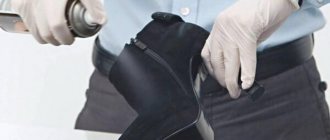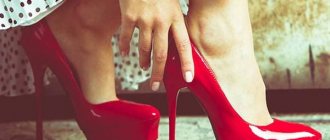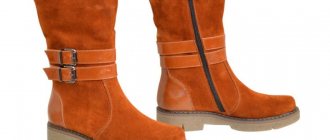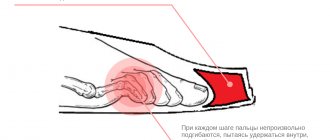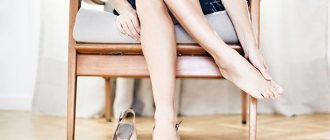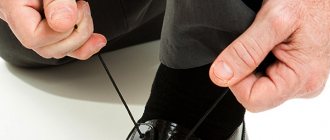Many owners of new shoes are faced with a common problem such as blisters. The joy of the happy owners of just purchased sandals or sneakers, shoes, boots immediately disappears.
We will share tips, recommendations, and interesting life hacks on the topic: what to do to prevent your favorite shoes from chafing in this article with a video. Of course, you can patiently break in your shoes, change the adhesive plaster every hour, and clench your teeth with every step. But leg health is hardly worth such sacrifices.
To avoid discomfort and not give up elements of a stylish look, you need to know what to do if your shoes rub, what secrets you need to use to make shoes, sandals or sneakers fit.
Shoes rub: what is the reason?
Shoes cause calluses in a variety of places: on the heel, toes, side, and even on the top of the foot. It all depends on individual sensitivity and design features of the product. Often the problem is concentrated in the back area, which can rub the delicate skin until it bleeds. Common reasons are an incorrectly selected size, a heel that has shrunk during improper storage, or its shape that does not match the characteristics of the foot.
Leather shoes also rub due to swelling of the feet. This often happens in the summer towards the end of the day, after a long walk or when you are in the same position for a long time. A pair that has been worn apart will eventually take on the desired shape and no longer cause discomfort, but a new one will have to be stretched naturally or this process will have to be forcibly accelerated. Here are two proven ways to do this:
- use a special stretching agent: foam or spray. They need to be applied to problem areas, put on shoes and walk in them for 2-3 hours without taking them off. If necessary, repeat the procedure once or twice;
- heat a tight pair over boiling water, and then put on a thick sock and wear it for several hours;
- Wipe the inner surface of the shoes with an alcohol-containing composition or castor oil and also wear them for several hours.
Specialty stores and shoe stores often sell clear, adhesive-based gel pads for different areas of the foot. If new shoes rub your heels, buy a set of pads for them and secure them from the inside - this will protect your feet from the appearance of calluses.
What to do with calluses
A callus is formed from excessive rubbing of the skin and is a bubble filled with liquid, which then bursts. An infection can easily penetrate an open wound, which can lead to suppuration and is very dangerous to health, so you should not take calluses lightly.
If the bubble in front of your toes or on the heel has burst, treat the area with peroxide, and then apply brilliant green around the wound. You can also use alcohol. There is no need to pour it onto the damaged area; do it with a cotton pad or ear swab. If the bubble is still full, press it with a clean bandage, and then carry out the disinfection procedure. An open wound can be sealed with a bactericidal adhesive plaster.
Shoes rub your toes
The comfort of your toes depends on the correct choice of toe shape - for example, models in which they are square or pointed are not suitable for everyone. Toes will only fit comfortably in shoes with a smoothly rounded front part, but this does not always prevent chafing. Silicone separators will help you cope with this problem; they will prevent your fingers from rubbing against each other, and will also protect your little fingers or big toes, depending on how you put this device on.
Shoemaker tips
To wear shoes without damaging the product, you need to follow the recommendations of professionals:
. To do this, a small amount of the substance is applied to an inconspicuous area of the product. The procedure is allowed only if there are no negative changes.
Regardless of which product you choose, you should make sure it is safe- It is permissible to use special products only when stretching natural leather. The artificial material will deteriorate under their influence.
- Patent leather shoes should not be doused with boiling water or placed in the freezer.
- When using a hair dryer, it is recommended to cover the material with a damp cloth. Due to this, it is possible to prevent the material from drying out.
- When using a hammer to soften it, it is important not to overdo it. Rigidity must be maintained, otherwise the shoes will become shapeless and even more uncomfortable.
The best and safest way to solve the problem is to seek help from professionals. An experienced shoemaker will be able to do the job efficiently without harming the material. It has all the necessary accessories to soften the backdrop.
Shoes rub your heel
What to do if your shoes rub your heels? If the reason lies in the dry and hard back of shoes or boots, soften it with pharmaceutical glycerin. Pre-prep your shoes by holding a warm, damp cloth in them. Take it out after it has cooled, and then apply glycerin to the inner surface. As an alternative, you can use any fatty or baby cream, hygienic lipstick, a piece of soap or a wax candle. You will have to treat the backdrops with them not just once, but several times until they stop rubbing.
If your shoes are rubbing, and there are a couple of hours left before leaving?
Do you have very little time left to adapt your shoes to painless and safe walks? You can use the same method with wet socks, but use alcohol instead of water, which dries much faster and further softens the natural material. But use alcohol to stretch shoes with caution, as it can change the color of the pair.
If your shoes are not too tight, a few hours before going out, you can lubricate your feet with rich baby cream, and try to ensure that it is absorbed into the skin as much as possible. This preventive measure will help prevent chafing.
Only an hour before going out, and you have absolutely nothing to wear for an important date? It's time to take emergency measures. You need to put on your shoes with the warmest socks, turn on the hairdryer and gradually blow hot air onto problem areas (heel, toe). At the same time, you should try to move your leg to speed up the stretching process.
Shoes rub on the sides or bottom
Autumn or winter shoes rub on the sides - this means that the chosen pair is too tight. To avoid calluses, use one of the stretching methods described above. Securely fixed insoles (preferably orthopedic or gel) will also help. Moving from side to side while walking, they rub along the contour of the foot.
Gel pads will save you from another problem - discomfort in the sole area. These sensations are especially unpleasant, so try to eliminate the problem as early as possible. For high-heeled shoes, the pads should be heart-shaped and fixed strictly on the area that experiences the greatest pressure while walking. If the shoes are too big, the foot slides in it and, accordingly, also becomes deformed. In this case, additional insoles will be useful if we are talking about a winter or autumn pair, or tightly tightened straps if these are summer sandals.
What to do if your leather shoes rub
Leather is a natural, completely environmentally friendly and durable material that stretches well over time, taking the shape of the foot. New clothes may chafe a little in any situation, but you must understand: this is a temporary phenomenon. However, the skin can be “helped” a little to quickly take on the desired contours and curves. This is done with the help of special means, in a shoe workshop or at home - as we described above. If the chafing problem is caused by excessive sweating, spraying the most dangerous areas with a special antiperspirant for feet will reduce friction and, therefore, reduce the likelihood of blisters.
One final piece of advice: If all the new shoes are making you uncomfortable, be proactive. Wear it indoors for several days, use gel pads or patches, and treat problem areas with greasy special products. And the Respect online store will help you with the selection and purchase of high-quality, stylish and elegant shoes that will delight you with their appearance and comfortable fit.
How to prevent problem areas from appearing?
Prevention is the best medicine. The measures taken within its framework affect both feet and shoes. Choose one of the methods presented for the legs and shoes and repeat many times, unless the instructions say otherwise.
Before the start of the season you need...
Feet are more comfortable in boots due to their design features. Boots, shoes and sandals are held in place by applying pressure to certain points. The places that apply pressure - the heel, toe, vamp, strap - are the ones that rub most often. Therefore, be sure to pay due attention to the areas of the body that come into contact with these parts of the shoe.
To prepare your feet for the summer-spring season after “resting” in boots, treat yourself to baths with the following components (choose one):
- chamomile (hold for 20 minutes);
- calendula (hold for 30 minutes);
- oatmeal (0.5 liters per basin of water, you can add a spoonful of pine needles);
- heated milk (liter per 3 liters of water, keep for half an hour);
- aroma oils (2 drops each of tea tree and bergamot, 3 drops of lavender, 10–15 ml of bath foam, 3 liters of water, a little cream; hold for 15–20 minutes).
After the bath, you need to treat the foot : remove roughness (do not overdo it, because wounds will easily appear at the site of damage in the future), tidy up your nails, do a massage using sunflower oil or a specialized cream. Upon completion of the manipulations, raise your legs up (put them on some elevation) and stay in this position for some time.
These activities should not be one-time in nature . You need to act systematically and for at least a week, and preferably 2-3 weeks. If you do this, you will not only prepare your legs for the season, but you will also be able to reduce the severity of swelling and also tidy up your lymphatic system.
What remedies help?
Panthenol, baby cream, Bepanten, which are sold in pharmacies, are excellent solutions for softening and preparing feet for the season of shoes and sandals . You can use them for a while or use them shortly before trying on new shoes. Shortly in this context is the time required for complete absorption.
Don't forget about the adhesive plaster . Do not ignore its preventive properties and protective functions: apply it before putting on problematic shoes or sneakers, and not after damage appears.
Traditional methods
When the question arises of how to wear a rubbing pair, you don’t have to go to the store. It is quite possible to achieve the desired effect using improvised means.
A hard back will soften faster if it is soaked. It is recommended to use vinegar for leather, and plain water for textiles. When the backdrop becomes wet enough, it must be gently wrinkled. You just need to pay attention that cardboard inserts are often used in textile products. Such influence will not benefit them.
Glycerin has proven itself well for leather items. It is easy to find at the pharmacy and the benefits can be impressive. The processing is carried out in this way. First you need to dip the towel in hot water, then it should be placed in the shoe. When it cools down, the shoes are lubricated with glycerin. Hot water will make the skin more receptive to the product.
Advice
A regular deodorant, roll-on or solid, will help you avoid calluses. You just need to lubricate the inside of your shoes.
If your shoes rub on the heel, you can use regular newspapers. They need to be torn into pieces and wetted generously. Then place it in the problem pair, stuffing the product very tightly, and leave to dry. It is not recommended to put it on the battery; the process should take place naturally.
It is no less convenient to use alcohol. Alcohol or vodka will do; you can even use cologne. You need to lubricate the inner surface, then put the shoes on your feet in warm socks. You need to walk like this for about half an hour. You just need to know that it is better to use beer for products made of fabric or suede. Otherwise, they are processed in the same way as leather ones.
Advice
It is not recommended to apply the product to the outside, as this may spoil the appearance of the shoes. Alcohol can change the condition and color of the material, so you should go outside in the treated steam only after it has completely dried.
Another popular folk method is freezing. Plastic bags should be filled with water and placed into problem items in such a way as to fill the areas that need to be stretched. It is better to take two bags for each boot, without tying the top one. This measure will help avoid an unpleasant situation if one of the packages turns out to be not too strong. The water will expand as it freezes, which will achieve the desired effect. Once the boots are removed from the freezer, it is not recommended to immediately remove the ice. You need to let it thaw a little. The method has proven itself quite well, but in rare cases the shoes crack or creases appear on them.
We recommend: 4 ways to clean suede or velor shoes without a brush
You can try a safer method. It is very simple: you need to thoroughly moisten the towel with water and wrap the box with the purchased pair. A humid microclimate is formed in the box, which helps to quickly soften hard skin. The procedure should be quite long, it is recommended to leave the towel on overnight. You may need to do this several times.
To break in uncomfortable shoes, you can lubricate the inside of them with castor oil. Another option is to lubricate the backdrop with a piece of soap or a candle. Friction will decrease, which means calluses will not appear.


